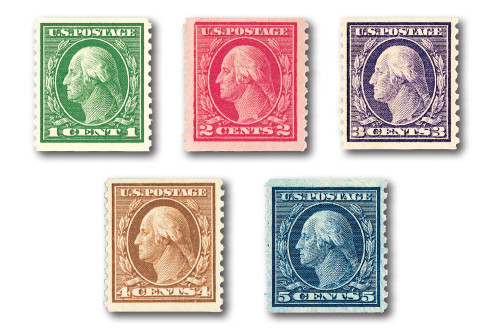
# 443-47 - Complete Set, 1914 Coil Stamps Perforated 10 Vertically
Are You Missing These 1914 Washington-Franklin Coils?
Flat Plate, Perforated 10 Vertically
The Washington-Franklins are among the most fascinating and challenging US stamps to collect. Issued between 1908 and 1922, they encompassed over 200 varieties, five different designs, two paper types, three printing methods, at least 14 perforations, several colors, and 20 denominations.
You can come one step closer to completing your Washington-Franklin collection with this convenient set of five stamps. Each of these stamps was printed on the flat plate press and perforated 10 vertically. These stamps were produced to answer calls from the public and postal workers…
Perforations Changes from 12 to 10
When the 1908 series was issued, all stamps were perforated 12 gauge. Soon, both the public and postal workers began complaining that the perforations were too close, and the stamps could not be handled without coming apart. It wasn’t until 1910 that the Post Office Department began taking their complaints seriously. At this time, the Bureau began producing coils on a machine that would automatically wind the stamps into coiled rolls. They soon found the 12 gauge perforations were much too brittle to be used, since the stamps were continually becoming separated in the coiling process.
These events brought about the change to 8 1/2 gauge perforations. However, this produced stamps that were difficult to tear apart, consequently ripping the stamps. Again, the perforations were changed, this time to 10 gauge. While this change was fine for coiled stamps, it was unsuitable for sheets, which had a tendency to tear rather than separate at the perforations. Eventually, it was decided that 11 gauge perforations were suitable for sheets, while 10 gauge perforations were best for coils.
Some of these stamps were only in use for a short time – as few as just two months. And #444 was the first perforated 10 stamp to be issued. Additionally, #446 and 447 were the last coil stamps of their denominations to be produced on the flat plate press before it was replaced by the rotary press.
Are You Missing These 1914 Washington-Franklin Coils?
Flat Plate, Perforated 10 Vertically
The Washington-Franklins are among the most fascinating and challenging US stamps to collect. Issued between 1908 and 1922, they encompassed over 200 varieties, five different designs, two paper types, three printing methods, at least 14 perforations, several colors, and 20 denominations.
You can come one step closer to completing your Washington-Franklin collection with this convenient set of five stamps. Each of these stamps was printed on the flat plate press and perforated 10 vertically. These stamps were produced to answer calls from the public and postal workers…
Perforations Changes from 12 to 10
When the 1908 series was issued, all stamps were perforated 12 gauge. Soon, both the public and postal workers began complaining that the perforations were too close, and the stamps could not be handled without coming apart. It wasn’t until 1910 that the Post Office Department began taking their complaints seriously. At this time, the Bureau began producing coils on a machine that would automatically wind the stamps into coiled rolls. They soon found the 12 gauge perforations were much too brittle to be used, since the stamps were continually becoming separated in the coiling process.
These events brought about the change to 8 1/2 gauge perforations. However, this produced stamps that were difficult to tear apart, consequently ripping the stamps. Again, the perforations were changed, this time to 10 gauge. While this change was fine for coiled stamps, it was unsuitable for sheets, which had a tendency to tear rather than separate at the perforations. Eventually, it was decided that 11 gauge perforations were suitable for sheets, while 10 gauge perforations were best for coils.
Some of these stamps were only in use for a short time – as few as just two months. And #444 was the first perforated 10 stamp to be issued. Additionally, #446 and 447 were the last coil stamps of their denominations to be produced on the flat plate press before it was replaced by the rotary press.







